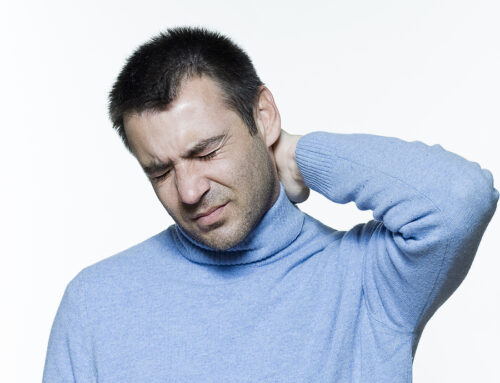 It may be hard to imagine that neck pain and other health problems are connected to sitting too much. The truth is, sitting for long periods of time is hazardous to your health in many ways. This article will tell you how dangerous sitting actually is and how to find relief if you are suffering from neck pain already.
It may be hard to imagine that neck pain and other health problems are connected to sitting too much. The truth is, sitting for long periods of time is hazardous to your health in many ways. This article will tell you how dangerous sitting actually is and how to find relief if you are suffering from neck pain already.
Table of Contents
How Sitting Impacts Your Health
Most of us realize that sitting for hours at a time can be bad for us. We may even feel a little guilty when we take part in a long binge of TV watching. But why is this so dangerous, especially if it is done day after day? The following bullet points help us see what goes on in our body1 when we sit for too long.
-
Organ damage
-
Heart disease – Muscles burn less fat and blood flows more slowly when you are sitting. This causes fatty acids to more easily clog the arteries. High blood pressure and increased cholesterol are connected to a sedentary lifestyle. People who sit for long periods are twice as likely to have cardiovascular disease than those who are more active.
-
Overproductive pancreas – The pancreas is responsible for producing insulin. Insulin is a hormone that brings glucose to the cells, and this gives energy to the body. However, if your muscles are idle, they will not properly respond to insulin, and the pancreas begins creating more and more. This causes diabetes and other health problems. How fast does this happen? According to a study done in 2011, a change in insulin occurred after just one day of prolonged sitting.
-
Colon cancer – Numerous studies have linked sitting to a greater risk for breast, colon, and endometrial cancers. It is unknown why this occurs, but one theory says that it is linked to the excessive amounts of insulin. This encourages cell growth. Another theory is based on the fact that moving on a regular basis increases your natural antioxidants to kill cell-damaging and possibly cancer-causing free radicals.
-
-
Muscle degeneration
-
Mushy abs – If you stand, sit up straight or move in any way, your abdominal muscles keep you upright. If you sit too long, you develop tight back muscles and weak abs — a combination that wreaks havoc on your spine’s natural arch and is called hyperlordosis or swayback.
-
Tight hips – If you have flexible hips, you are balanced and in good shape. Those who sit for too long rarely use the hip flexor muscles in front. These become short and tight and limit your range of motion. In the elderly, decreased hip mobility is the main reason they fall.
-
Weak glutes – When you sit, your glutes are doing nothing, and they get used to doing nothing. Soft glutes are developed, and your stability is negatively impacted.
-

-
Leg disorders
-
Poor circulation in the legs – Sitting for long periods slows the circulation of your blood, causing fluid to pool in the legs. This can lead to swollen ankles, varicose veins, and dangerous blood clots called deep vein thrombosis.
-
Softer bones – Walking and running stimulates hip and lower body bones to grow thick and strong. A recent surge in osteoporosis has been noted and is contributed to lack of activity.
-
-
Problems in the top of the body
-
Foggy brain – To get fresh blood and oxygen to the brain, we must move our muscles. This pumps blood to the brain and helps release natural mood-enhancing chemicals. Being sedentary slows everything down, and this includes thinking ability and brain function.
-
Sore shoulders and back – Slumping forward overextends the back and shoulder muscles.
-
Neck pain – Craning your neck forward to see your computer screen or keyboard or tilting your head so as to hold the phone between your ear and shoulder strains the cervical vertebrae and causes imbalances.
-
-
A bad back
-
Inflexible spine – Movement causes the soft discs between the vertebrae to expand and contract like sponges, soaking up nutrients and blood. Sitting causes these discs to be squashed unevenly.
-
Disc damage – Those who sit for long periods are more likely to get herniated lumbar discs.
-
-
Mortality
-
People who sit and watch TV were observed in an 8.5-year study. They had a 61 percent higher risk of dying than those who watched less than one hour of TV per day.
-
Finding Help for Neck Pain and Other Sitting-Related Health Problems
If you find yourself sitting too much and are starting to reap the side effects mentioned above, you may want to schedule an appointment with your nearest upper cervical chiropractor. The neck is a delicate structure made up of nerves and muscles. If you overextend your neck muscles — whether this is due to wear and tear, sitting for too long, or an accident of some sort — you may have a misalignment in the top bones of your spine, causing you to have neck pain or other issues. Keeping the C1 and C2 vertebrae in proper alignment can help you feel better overall.
We use a gentle method which does not require us to pop or crack the neck or spine in order to realign these bones. Rather, we encourage the bones to move back into place naturally so as not to add more stress to the body. This also results in a longer-lasting adjustment. This is often all that is needed to see relief from neck pain
.
To schedule a consultation with Upper Cervical Chiropractic San Diego, call 858-434-5926 or just click the button below.
If you are outside of the local area you can find an Upper Cervical Doctor near you at www.uppercervicalawareness.com.







